What I ate on my holidays, and how you can cook it at home
May 2nd, 2012
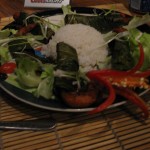 I’ve recently returned from an adventure through several Asian countries, where I checked out the local history, culture and cuisine. Even the odd appliance!
I’ve recently returned from an adventure through several Asian countries, where I checked out the local history, culture and cuisine. Even the odd appliance!
Here are a few of the local delicacies I sampled on the road, and a quick guide on how you can prepare them yourself.
No passport required; just a few handy appliances.
Cambodia: Fish Amok
Phnom Penh and Siem Reap are amazing destinations. The first has a long, often confronting history from which it is still recovering, but is still optimistic and growing. The second is booming from the tourist trade thanks to its location next to the thousand year old temples of Angkor, possibly the only finalist in the New Seven Wonders of the World where monkeys run (relatively) wild and free.
In both destinations, I ate amok, a curry that’s traditionally prepared with coconut milk, steamed fish and a bit of chilli, wrapped in banana leaves. Very tasty, a bit different to many other curries, and not impossible to make at home.
There is plenty of room for variation in online recipes for amok. Pretty much any meaty white fish can be used, from catfish to the blue-eye fillet mentioned. Combining the many ingredients for the kroeung curry paste involves a fair bit of preparation, so a good food processor would be super-useful.
If you want to save a bit more time and effort while you’re creating serving platters out of banana leaves and toothpicks, you can use a rice cooker to get the rice ready without hassle, and you can use a steamer for the final steps if you don’t have any of those bamboo steamer containers handy.
Vietnam – Banh Mi
From Hanoi to Ho Chi Minh City, if you need a quick feed in any Vietnamese city, you can always rely on finding a cart on a street corner selling banh mi, delicious sandwiches made with baguettes, pate, coriander and an assortment of other ingredients. It’s pretty easy to find banh mi in Australia as well – just visit your local Vietnamese bakery – but you can always try making your own.
The first step to making your own banh mi is the bread – in fact, to get technical, “banh mi” is the Vietnamese word for “bread”, and has been adapted to cover the sandwiches too. Even though the French left Vietnam in the 1950s, their influence is still felt in Vietnam’s strong tradition of baking, resulting in the banh mi bread used by street vendors typically being restaurant-quality delicious.
While I’m pretty sure that Vietnamese bakers use something a bit bigger than home bread makers, to cope with sheer demand, these are fine for those of us that can only eat a couple of banh mi. You may need to perform some experiments with the dough and preparation to perfectly recreate the light and fluffy texture of the banh mi bread roll.
As for the other ingredients, you can pretty much add what you want. Pork or chicken are common fillings, along with salad. Pate is commonly included, as is soft cheese. Online recipes often provide a wide range of potential options. For an interesting twist, try making a breakfast banh mi – the one pictured earlier included an omelette of egg and pate, with soft cheese, meat, salad and chilli. Breakfast of champions.
Beijing – Pineapple rice
Understandably, the capital of China is the place where the unique Chinese culture is the most strongly represented, and a big part of that is food. Eating out in Beijing is a communal affair, and often involves preparing part of your food for yourself on a tabletop barbeque or hotplate.
If you’re slack like me though and didn’t properly practice your Mandarin before arriving, what you order in a Beijing restaurant may not always turn out to be what you expected. One of the best surprises I experienced was accidentally ordering Pineapple Rice. The presentation is amazing, with the rice being served in its own pineapple, and taking on its sweet flavour.
Following a bit of research, it looks like making this dish at home is certainly possible, but takes a bit of preparation, involving hollowing out a pineapple, soaking glutinous rice overnight, and adding sugar and honey. I’m sure that my experiments with this over the next week or so are going to involve a lot of unnecessary fruit destruction.
If you don’t have a steamer or steam oven handy, or if a pineapple is too big to fit in what you have, it should be possible to steam in your microwave with a microwave-safe plastic container and some water. Let me know how you go.
Hong Kong – Veggie spring rolls
As an international city with a Futurama skyline and influences from China, Britain, Japan and more, Hong Kong is the place to go for pretty much anything that’s expensive and classy, or tacky and covered in glitter. Seriously, whatever you like.
One major attraction outside of the city of Hong Kong itself is the Po Lin Monastery at Ngong Ping, Lantau Island, home of the Tian Tan Budhha or “Big Buddha”, which certainly lived up to its name when I saw it, even if the foggy weather meant I couldn’t make out Buddha’s face.
While the place is in part organised like a tourist attraction, it’s still a functioning monastery, meaning that the attached restaurant and café exclusively serve vegetarian food for the benefit of its Buddhist pilgrims. A staple of the monastery café (and many other places throughout Asia and beyond) is the humble veggie spring roll.
Online recipes can give you the basics on how to prepare spring rolls, though they take practice and can be fiddly for a beginner, thanks to the finely-chopped veggies and fragile rice paper. However, they can really pay off in the taste department as you’ll be able to adjust your ingredients to suit the kind of flavours you prefer (adding prawns or other meats if you’re not vegetarian). What’s more, you can eat them cold or give them a blast in a deep fryer for a crispier experience.
I discovered this for myself in Halong Bay, Vietnam, where a chef showed our small cooking class how to roll and prepare the spring rolls, and even create garnishes in the form of carrot flowers. Apparently, it’s all in the slicing.
As you can see, ours were not quite as good. Next time…

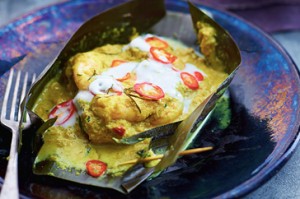
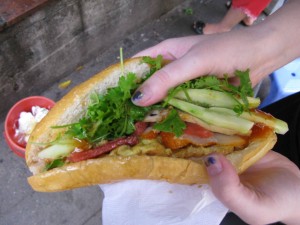

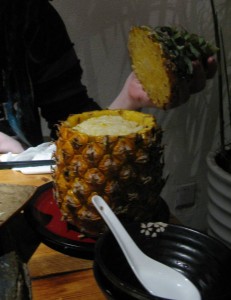


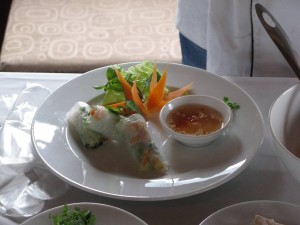
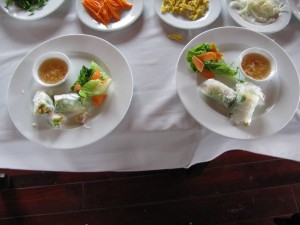

Leave a Reply